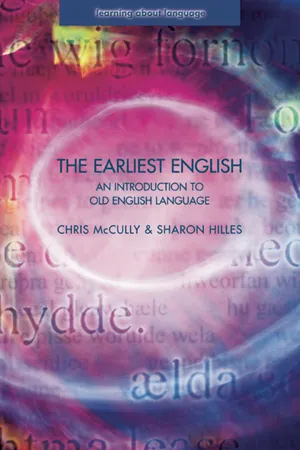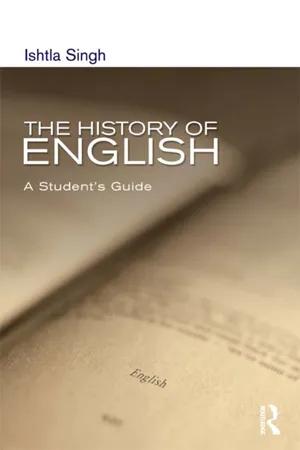Old English
Old English refers to the early form of the English language spoken and written in England from around the mid-5th century to the mid-12th century. It is the language of the epic poem "Beowulf" and other early English literary works. Old English is characterized by its use of Germanic roots and inflections, and it has a distinctively different vocabulary and grammar from modern English.
6 Key excerpts on "Old English"
- eBook - ePub
The Earliest English
An Introduction to Old English Language
- Chris Mccully, Sharon Hilles(Authors)
- 2016(Publication Date)
- Routledge(Publisher)
...Some scholars use the terms interchangeably, but we won’t. In this book we’ll use the term Old English to mean one or other of the varieties of the language widely spoken in England in the six centuries between the approximate dates of 449 and 1150. We’ll use the term Anglo-Saxon to refer to everything else, such as the people(s), culture and archaeology. We might speak, for example, of ‘an Anglo-Saxon brooch’ or ‘an Anglo-Saxon king’. We won’t speak of an ‘Old English king’ – the phrase is in any case ambiguous – but we will talk about entities such as the ‘Old English vocabulary’ and ‘Anglo-Saxon kings’. We’ll also use some abbreviations (initial lists, of both abbreviations for languages and for some grammatical terms, are given at the beginning of the book). OE, as you’ll have already noticed, will stand for Old English, the language spoken across most areas of what’s now, geographically, England from the 5 th to the 12 th centuries. Beowulf, one of the most famous epic poems in what can be called English, is an example of OE, as is Cædmon’s Hymn, which was composed in the late 7 th century (a West Saxon version of this text can be found later in this unit). ME will stand for Middle English, the version of English spoken in roughly the same area from around 1100 to about 1500. Chaucer’s Canterbury Tales is written in a London dialect of what we’re calling Middle English. Early Modern English (eModE) will cover roughly 1500 to c.1800, and includes the language of Shakespeare, Spenser, Milton and the King James Bible. Now, you’ll find abbreviations such as OE, eME, eModE and PDE in many standard handbooks. It’s convenient to divide the history of the English language up in such a way but, of course, such divisions are a gross simplification and involve much fudging. This fudging is often concealed in terms such as ‘roughly 1500 to c.1800’. In fact, there is both a range and a variety of ‘Englishes’...
- Edith Elizabeth Wardale(Author)
- 2018(Publication Date)
- Routledge(Publisher)
...C HAPTER I Old English LITERATURE Before entering upon a detailed study of individual works it would be well to consider briefly the general character of the vernacular literature of the Old English period, that is of the time between the coming of the Angles and Saxons to Britain in the fifth century and the Norman Conquest. The Latin writings, important as some of them are, do not concern us here. In the first place it may be observed that all the earliest O.E. literature is in poetic form, and that it is to the poetry that we must look chiefly for the characteristics of the period. The prose arose later and shows such strong foreign influence that it is necessarily less individual in character. In the poetry we have achievement, in the prose chiefly promise. The ultimate source of the poetry is to be found centuries earlier on the Continent in the songs which the Germanic tribes composed in honour of their great men. Though, unfortunately, none of these lays have come down to us, their existence is proved by mentions of them in early writers, as when Jordanes 1 and Priscus 2 tell us that hero lays were sung among the Germanic tribes, extolling the deeds of their great men, and Tacitus 3 mentions such poems as having been made already in his day. Further, some general knowledge of these songs, of the heroes thus honoured, and of the style of treatment in them may be gathered from extant poems, especially from those in Old English and Old Norse Literature. Such a knowledge, meagre though it must be, is valuable in helping us to distinguish between the native and foreign elements as we trace the development of the poetry through the various modifications it underwent during the O.E. period. How soon these lays developed into epic form or into something more like that of the Northern Sagas, it is impossible to say...
- eBook - ePub
- David Graddol, Dick Leith, Joan Swann, Martin Rhys, Julia Gillen, David Graddol, Dick Leith, Joan Swann, Martin Rhys, Julia Gillen(Authors)
- 2020(Publication Date)
- Routledge(Publisher)
...It is also likely that Alfred commissioned the writing of The Anglo-Saxon Chronicle, which provides an account of Anglo-Saxon history from a Wessex point of view. And according to the Oxford English Dictionary, the word Englisc (' English') was first used to denote both people and language under his auspices. In the tenth century there was another revival of learning and literary activity, this time associated with the influential Benedictine monasteries. The scriptorium of the monastery at Winchester, producing texts in the West Saxon dialect, seems to have made considerable efforts to regularise spellings and this has been seen as a move in the direction of standardisation in English. (See another book in this series, Graddol et al, 2007, for further discussion of this issue). Most extant Old English manuscripts date from the late Old English period and they preserve, not only translations of learned Latin texts, but also an important body of vernacular literature in prose and poetry. Some of the poems are religious, following the example set by Caedmon, and others (such as Beowulf) stem from inherited Germanic traditions. So far we've looked at Old English: where it came from, what it was like, how certain aspects of it changed, and how the process of change might be explained. We now move on to a different period of the English language, that known as ' Middle English'. 2.6 The transition to Middle English We have seen that the English language was undergoing significant change during the early part of the tenth century. In 1066 an event occurred that was to have a profound effect on this process. In that year a French-speaking dynasty from the dukedom of Normandy was installed in England. This external event has long been seen as decisive, not only for the history of England (and consequently Britain) but for the English language as well...
- eBook - ePub
The History of English
A Student's Guide
- Ishtia Singh(Author)
- 2013(Publication Date)
- Routledge(Publisher)
...We will return to the development of a standard form of English in Chapters 5 and 6. 3.4 The Language of Old English In this section, we will consider some of the typical features of Old English (OE) usage. There are, however, a few provisos we should bear in mind. First, and importantly, our knowledge of OE is based wholly on surviving textual material which, while providing a rich source of information (Baugh and Cable, 2002: 69), does not provide a comprehensive record of the language. Nor do we have complete copies of every text ever produced, nor do we know, with absolute certainty, what OE was actually like in the mouths of its everyday speakers – a not unimportant consideration when we consider the difference between everyday speech and formal writing. Thus, extant OE texts give us only an indication of contemporary, formal language use, specifically in the written medium, and not a full picture of the OE speech community. In addition, as we have already mentioned, the OE database is heavily concentrated in one dialect area of Anglo-Saxon England, namely Wessex. Most textbooks (including this one) therefore describe linguistic features that pertain mainly to West Saxon. We should remember, however, that OE, like any other living language, was not uniform across the general speech community. There were, for example, regional dialectal divisions, initially established by the settlement of the various Germanic tribes in different areas of England, and continued by the varying rates and directions of change that each underwent in its particular environment. The available evidence has allowed scholars to distinguish four main dialects: Northumbrian, Mercian (sometimes collectively known as Anglian), West Saxon and Kentish. Northumbrian and Mercian were spoken in the areas of mainly Anglian settlement north of the Thames, while Kentish emerged in its namesake Kent, which became home to mainly Jutish communities...
- eBook - ePub
- Russell Kirk(Author)
- 2017(Publication Date)
- Routledge(Publisher)
...This fusion simplified the general English tongue, gradually— which became an advantage for the English, long later. Until the seventh-century Christian missionaries from Ireland (speaking Celtic) began to school the northern English, and the Christian missionaries from Rome (speaking Latin) set to work among the southern English, the Anglo-Saxon peoples had no writing. Scalds and bards chanted or shouted their heroic poems (Beowulf the chief of these epics), and recited chronicles of kings. Not until King Alfred, late in the ninth century, directed the translation of some important Latin works into the English of the kingdom of Wessex, and commenced the writing of the Anglo-Saxon Chronicle, did a written prose literature begin to develop. In the course of five centuries and longer, only modest progress toward a high culture had been made among English-speaking folk. 3 Into this rather somnolent culture of the English there burst, in the year 1066, the Norman power. French-speaking William the Conqueror, swiftly mastering the whole of England, stripped the Saxon nobles and the Saxon Church of their powers, their honors, and their lands. Norman French promptly became the language of the court, of the king’s vassals who now were given power almost absolute in every shire, and of vernacular literature. Only the peasantry, after the Norman Conquest, clung to English speech. In the twelfth century it was said that two languages were spoken in the kingdom of England: Latin for the learned, French for the vulgar. No one worth mentioning still spoke the despised English. 4 Nevertheless, this seemingly dreadful blow to the English language paradoxically hastened the efficient development of that tongue. Not many years after the Conquest, Old or Early English gave way to the speech called Middle English...
- eBook - ePub
Linguistics for Language Teachers
Lessons for Classroom Practice
- Sunny Park-Johnson, Sarah J. Shin(Authors)
- 2020(Publication Date)
- Routledge(Publisher)
...Additionally, English has changed so much in the last few centuries that if we were to listen to a clip of Old English or Middle English, we would not be able to understand it at all. Most linguists divide English into roughly four historical phases: Prehistory (to c. 450), Old English (c. 450–c. 1150), Middle English (c. 1150–c. 1450), and Modern English (c. 1450–present). This chapter shows the extensive phonological and grammatical changes English has undergone throughout its history, often as a result of contact with other languages such as Old Norse, French, and Latin. It also explains the role of the printing press in stabilizing English spelling. 9.2 Prehistory (to c. 450) The languages spoken by the original inhabitants of the British Isles belonged to the Celtic (pronounced /kɛltɪk/) family. Modern-day examples of Celtic languages include Gaelic (in Ireland), Welsh (in Wales), and Breton (in Northern France). The Celts had come to the islands around the middle of the first millennium BC and were, in turn, subjugated by the Romans, who arrived in 43 BC. While the Romans were initially reluctant to colonize this land, they did ultimately occupy Britain in a serious way, and introduced Christianity. The main Roman era spanned two centuries, from c. 200 to c. 400. As the Roman Empire came under increasing attack from the Goths and other tribes, however, the Romans retreated closer and closer to home, abandoning their more far-flung colonies. By 410, the Roman armies had left the British Isles to help defend their empire in Europe. Neglected by the Romans, the British Celts turned to powerful Germanic tribes for protection. The Jutes, the first group to arrive, came from Jutland, in the northern part of modern-day Denmark, and settled in southern and south-eastern Britain. Later, the Angles and the Saxons came from the south of the Danish peninsula and settled in Britain...





